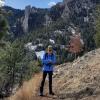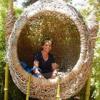Groups joined
Groups
Group
- Latest Resource
- /
- Underwater advertisement call of the threatened Telmatobius rubigo (Anura: Telmatobiidae
In a recent publication we tested Underwater Passive Acoustic Monitoring (UPAM) as a feasible non-invasive technique to study the calling behavior of therathened aquatic Andean frogs under natural conditions in the extreme environments of PUNA in the central Andes of Argentina
Group
- Latest Resource
- /
- Join the Seeed Vision Challenge and Explore Conservation Tech!
Join the Seeed Vision Challenge, an opportunity for conservation innovators to harness the power of AI vision sensors for environmental monitoring and protection.
Group
- Latest Discussion
- Newt belly pattern for picture-matching
- Latest Resource
- /
- The Variety Hour: 2024 Lineup
You’re invited to the WILDLABS Variety Hour, a monthly event that connects you to conservation tech's most exciting projects, research, and ideas. We can't wait to bring you a whole new season of speakers and discussions!
Group
- Latest Resource
- /
- My Experience and Takeaways at the 1st WildlifeScientific Conference
Pomp!! Color! glamour and jubilation filled the first ever wildlife scientific conference dubbed “Use of Wildlife Science for enhanced Biodiversity Conservation and improved Livelihoods” that took place at the Lake Naivasha Resort, in Naivasha - Kenya, from its very first day of 26th to its close on 28th September, 2023. The conference brought together all kinds of people and sundry, brains with diverse thinking, innovative ideas and resolutions to the innumerable challenges facing wildlife species and their habitats coupled with the ever arching conflicting interactions between humans and wildlife.
Group
- Latest Discussion
- Seeking Knowledge/Resources about Soil Monitoring
- Latest Resource
- /
- Underwater advertisement call of the threatened Telmatobius rubigo (Anura: Telmatobiidae
In a recent publication we tested Underwater Passive Acoustic Monitoring (UPAM) as a feasible non-invasive technique to study the calling behavior of therathened aquatic Andean frogs under natural conditions in the extreme environments of PUNA in the central Andes of Argentina
Group
- Latest Discussion
- Thoughts on RooBadge?
- Latest Resource
- /
- Become a WILDLABS group manager!
Are you interested in getting more involved in the WILDLABS community? Do you want an opportunity to build your network and get more connected to other conservation tech folks in your field? Apply to be a group manager!
Group
- Latest Discussion
- Newt belly pattern for picture-matching
- Latest Resource
- /
- Underwater advertisement call of the threatened Telmatobius rubigo (Anura: Telmatobiidae
In a recent publication we tested Underwater Passive Acoustic Monitoring (UPAM) as a feasible non-invasive technique to study the calling behavior of therathened aquatic Andean frogs under natural conditions in the extreme environments of PUNA in the central Andes of Argentina
Group
- Latest Discussion
- Introduction + Mentorship/Research Partnership
- Latest Resource
- /
- The Variety Hour: 2024 Lineup
You’re invited to the WILDLABS Variety Hour, a monthly event that connects you to conservation tech's most exciting projects, research, and ideas. We can't wait to bring you a whole new season of speakers and discussions!
Group
- Latest Discussion
- WILDLABS AWARDS 2024 – MothBox
- Latest Resource
- /
- Underwater advertisement call of the threatened Telmatobius rubigo (Anura: Telmatobiidae
In a recent publication we tested Underwater Passive Acoustic Monitoring (UPAM) as a feasible non-invasive technique to study the calling behavior of therathened aquatic Andean frogs under natural conditions in the extreme environments of PUNA in the central Andes of Argentina
Group
- Latest Discussion
- Ethics in conservation
- Latest Resource
- /
- Holistic, Ethical & Community-led Human-Wildlife Conflict Solutions with Gabriela Fleury
Listen in on our interview with human-predator conflict expert, Gabi Fleury and gain a deeper understanding of the importance of holistic, ethical and community-led approaches to developing tech solutions for conservation.
Group
- Latest Discussion
- Autonomizing Small Mammal Traps
Group
- Latest Resource
- /
- HWC Tech Challenge update 2020
An update on @Alasdair and @adanger24's HWC project
Group
- Latest Discussion
- WILDLABS AWARDS 2024 – MothBox
- Latest Resource
- /
- Underwater advertisement call of the threatened Telmatobius rubigo (Anura: Telmatobiidae
In a recent publication we tested Underwater Passive Acoustic Monitoring (UPAM) as a feasible non-invasive technique to study the calling behavior of therathened aquatic Andean frogs under natural conditions in the extreme environments of PUNA in the central Andes of Argentina
Group
- Latest Resource
- /
- The Variety Hour: 2024 Lineup
You’re invited to the WILDLABS Variety Hour, a monthly event that connects you to conservation tech's most exciting projects, research, and ideas. We can't wait to bring you a whole new season of speakers and discussions!
Group
Watch our interview with pioneering young Tanzanian vulture researcher Vainess Laizer! Her research investigating the breeding success of white-backed vultures in the western corridor of the Serengeti ecosystem using camera technology is an excellent inspiration for how to get started in a career in conservation tech.
Group
- Latest Resource
- /
- Underwater advertisement call of the threatened Telmatobius rubigo (Anura: Telmatobiidae
In a recent publication we tested Underwater Passive Acoustic Monitoring (UPAM) as a feasible non-invasive technique to study the calling behavior of therathened aquatic Andean frogs under natural conditions in the extreme environments of PUNA in the central Andes of Argentina
Group
- Latest Discussion
- Newt belly pattern for picture-matching
- Latest Resource
- /
- Underwater advertisement call of the threatened Telmatobius rubigo (Anura: Telmatobiidae
In a recent publication we tested Underwater Passive Acoustic Monitoring (UPAM) as a feasible non-invasive technique to study the calling behavior of therathened aquatic Andean frogs under natural conditions in the extreme environments of PUNA in the central Andes of Argentina
Group
- Latest Discussion
- Drop-deployed HydroMoth
- Latest Resource
- /
- Ashored Innovations: Hardware and Software for Sustainable Fishing
In this Conservation Tech Showcase case study from Ashored Innovations, we’ll learn how conservation technology is transforming fishing techniques to safeguard marine wildlife.
Group
- Latest Discussion
- Species ID Needs?
- Latest Resource
- /
- Here's what you missed at World Wildlife Day 2024
Catch up on the conservation tech discussions and events that happened during World Wildlife Day 2024!
Group
- Latest Discussion
- Introduction + Mentorship/Research Partnership
- Latest Resource
- /
- Celebrating #IWD2024 in Collaboration with SHE Changes Climate, Shortlist Futures & Women in Renewable Energy
On 27th March, our Women in Conservation Technology Programme Kenya Alumni and East Africa Community participated in a vibrant #IWD2024 gathering in Nairobi in collaboration with other women-focused organisations centered on enabling conversations and knowledge-exchange on the gender and climate nexus, expounding on the theme #InvestInWomen. Here is a brief overview on the event and takeaways!
Collections
Keep track of the resources that matter to you! Collections let you save, organise, and share content from all over the WILDLABS community. Create your first collection by clicking on the bookmark icon wherever you see it.
























































































































Ronan Hugtenburg's Comments
Be part of the conversation! Once you've joined a discussion in the community, your comments will show up here.